Confocal Microscope Scanning Systems
Confocal imaging relies upon the sequential collection of light from spatially filtered individual specimen points, followed by electronic signal processing and ultimately, the visual display as corresponding image points. The point-by-point signal collection process requires a mechanism for scanning the focused illuminating beam through the specimen volume under observation. Three principal scanning variations are commonly employed to produce confocal microscope images. Fundamentally equivalent confocal operation can be achieved by employing a laterally translating specimen stage coupled to a stationary illuminating light beam (stage scanning), a scanned light beam with a stationary stage (beam scanning), or by maintaining both the stage and light source stationary while scanning the specimen with an array of light points transmitted through apertures in a spinning Nipkow disk (see Figures 1 and 2). Each technique has performance features that make it advantageous for specific confocal applications, but that limit the usefulness in others.
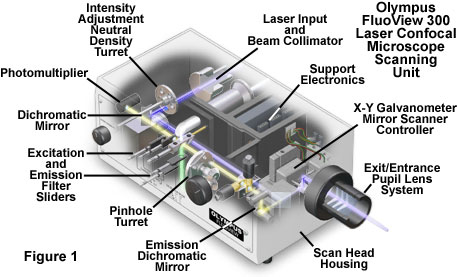
The stage-scanning and beam-scanning configurations are single-beam methods, while the spinning disk approach is a multi-beam scanning technique. Systems employing the Nipkow disk-scanning concept have typically utilized noncoherent broad-spectrum light sources (such as arc-discharge lamps) for illumination rather than lasers, and the overall lack of brightness has severely limited their use in fluorescence applications. More recently, microlens arrays and sophisticated disk design enhancements, coupled to laser illumination, have expanded the potential applications for spinning disk confocal microscopes. Nipkow disk systems may be designed in either tandem scanning or monoscanning variations. In the former, the illumination and detection beams follow tandem pathways through separate sets of identical apertures located on diametrically opposite sides of the disk. The monoscanning system performs illumination and detection simultaneously through each rotating aperture on the disk, maintaining the coincidence that the two light paths exhibit while passing through the objective.
An additional method of single-beam scanning has experienced limited application in specialized reflected light microscopes, primarily for integrated circuit inspection. The objective itself may be scanned over a stationary specimen utilizing a stationary light source in a scanned-lens system. This configuration has similar optical advantages to stage scanning, but allows the stationary specimen to be fitted with measuring probes, or otherwise manipulated. The configuration is not amenable to rapid scanning when a relatively massive conventional objective is employed, and is therefore not widely utilized.
The modern confocal microscope is an integrated electronic system, most commonly based on a widefield epi-fluorescence instrument, with the addition of multiple laser illumination sources, a scan head containing electronic and optical components, a computer and monitor for image display, and associated software for control of signal acquisition, processing, and image analysis. In the basic confocal optical configuration, the objective forms an image of both the source and detector pinholes on the specimen plane. By positioning the pinholes on the microscope optical axis in conjugate focal planes, their images overlap within the specimen focal plane. Although fluorophores outside the plane of focus are excited, detection is limited to emission occurring near the focal plane by the detector pinhole aperture, which rejects out-of-focus light. The single-beam laser scanning confocal microscope functions in this point-scanning mode as a sampling device and does not form an optical (real) image. To enable image formation, the sampling spot must be moved through the specimen and the resulting signal collected and stored. The scan head controls the generation of photon signal required to construct the confocal image. The components of a typical commercial scan head are illustrated in Figure 1, and generally include one or more laser inputs, fluorescence filter sets, a raster scanning mechanism, one or more pinhole apertures, and detectors (usually photomultiplier tubes, PMTs) for multiple fluorescence wavelength detection.
In order to extend the confocal point-sampling principle to allow generation of an extended specimen image field, the point focus in the specimen is scanned in a raster pattern similar to that employed to create the image on a television screen (and in other video applications; see Figure 2(a)). This mechanism requires a fast horizontal scan (the line scan) in conjunction with a slower vertical scan, or frame scan, which offsets the scanning line to sequential positions from top to bottom of the frame. During the history of confocal microscope development, a number of different techniques have been employed to implement point scanning, and several have been refined into current commercial versions. In single-beam laser scanning instruments, a typical raster scanning mechanism utilizes two high-speed oscillating mirrors driven by galvanometer motors, which pivot on mutually perpendicular axes. Coordination of the two mirrors, one scanning along the x-axis and the other on the y-axis, produces the rectilinear raster scan. The scanning speed of the mirrors is negligible compared to the speed of light, and consequently the emitted fluorescence can be collected by the objective and returned, or descanned, along the original illumination path to its conjugate focal plane at the detector pinhole. Variation in the signal intensity illuminating the detector aperture corresponds to variations in emission at different points in the specimen as the exciting beam is scanned.
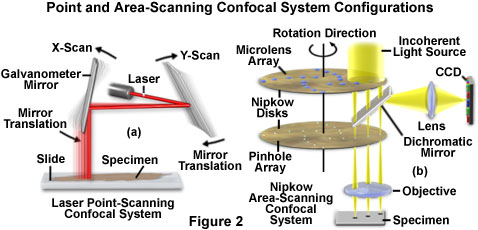
Several characteristics of an ideal confocal scanning system, required to provide optimum imaging performance, are extremely difficult to achieve in practice. Nearly all scanning system configurations present some shortcomings in operation, and various optical and electronic design modifications have been introduced in an attempt to correct the deficiencies. Several methods of implementing point scanning reduce sensitivity or involve severe compromises in flexibility or image quality, and are not currently used in commercially produced systems. One of the most important requirements of the scanning system design is that the objective pupil (rear focal aperture) is completely filled with light during the entire scanning cycle in order to prevent illumination fall-off at the scan extremes. This is best accomplished by minimizing movement of the beam at the aperture with a scan design that pivots the beam at a stationary point that is conjugate with the objective rear aperture. Maintaining a stationary pivot point when the beam is rocked during scanning is technically challenging, and some systems compensate for a small amount of beam movement by overfilling the aperture through increased beam expansion. This has the disadvantage of wasting light and reducing the photon efficiency of the system.
An additional desirable property of the confocal scanning mechanism is to scan at the highest frame rate possible in order to provide the flexibility to adjust various scanning modes to match the imaging application. This requires minimal inertia of the moving components that produce the beam scanning, as well as minimizing the system dead time, (or interval between each scanning cycle) in which the beam is not scanning the specimen. The proportion of each full-frame scanning interval that is utilized to actually scan the specimen is referred to as the duty cycle of the system. Minimizing non-productive scanning of the beam is not only essential to achieving a high frame rate, but in some instrument designs, reduces the unnecessary specimen photon damage that results from a poor duty cycle specification.
The capability to freely rotate the scan raster around the optical axis is a very important feature for confocal imaging as a means to optimize the scan direction with respect to specimen shape or other characteristics. When imaging elongated features such as fiber bundles, orientation of the fast scan direction parallel to the long axis of the feature greatly enhances the time resolution of the specimen signal. Furthermore, the ability to rotate the raster allows specimen features to be oriented in a manner that utilizes the image field most efficiently. Scanning arrangements that do not permit rotation of the raster direction can seriously limit the practicality of the system, unless the specimen itself can be easily rotated, a much more problematic operation that is not usually feasible.
The optical arrangement required to produce a linear motion of the illumination spot in the specimen is derived from consideration of the geometrical optics of the microscope, including the fact that the objective is telecentrically corrected (a telecentric lens system positions the entrance and exit pupils at infinity). To realize the full optical correction of the objective, the image and specimen planes must remain at fixed distances from the objective, and the locations of the conjugate image planes and conjugate telecentric planes are therefore known. A critical optical property is that all light beams intersect a telecentric plane at an angle that is a function of the position of the source point in the specimen plane. Since a flat mirror is capable of changing the angle of propagation of a light beam, the placement of a mirror at a conjugate telecentric plane on the optical axis provides a mechanism by which a change in beam angle will produce a linear motion of the focal point in the specimen. Therefore, in the simplest case, the positioning of a mirror with its pivot point at the center of the objective conjugate telecentric plane produces a one-dimensional beam scanner capable of changing the position of the illuminated spot in the specimen plane as a function of the mirror's pivot angle. Any conjugate telecentric plane is an image of the objective telecentric plane. When an intermediate optical system is employed, it forms an image of the mirror in the entrance aperture of the objective, maintaining the telecentric properties.
In principle, this scanning concept can be expanded into two perpendicular axes by simultaneously scanning the mirror in two directions or by adding a second mirror, although practical considerations generally determine the type of approach taken for a particular overall system design. When two mirrors are employed to scan the beam in perpendicular directions, they should be placed in conjugate telecentric planes, or alternatively, located in close proximity to one another (close-coupled). By deflecting the beam in orthogonal directions, such a scanning system can generate the fast and slow scan motions along the x and y axes necessary to form a complete two-dimensional image.
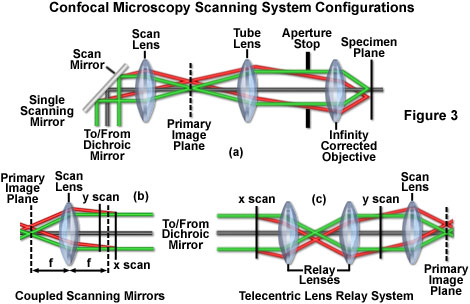
Various arrangements of scanning system components are possible provided that the primary requirements are satisfied. To ensure diffraction-limited performance of the optical system, the objective rear focal plane (entrance aperture) must constantly be uniformly filled by a planar wave during scanning. Because the physical diameter of this aperture varies with properties of the objective, all other components, including illumination pinholes, must be matched to the objective(s) in use. Conjugate telecentric planes can be produced in required locations by the addition of auxiliary optics, and if this approach is taken, the properties of these must also be carefully considered in regard to their compatibility with the objectives chosen for use with the system. The beam properties of illuminating lasers, in particular the diameter of the Gaussian beam profile, are significant factors in adjustment of pinhole diameter and other variables related to illumination of the objective entrance aperture.
In the simplest beam-scanning confocal configuration, a scan mirror is located in the rear focal plane of a scan lens, which is conjugate with the rear focal plane of the objective. Illustrated in Figure 3(a) is a single-mirror arrangement, which includes the tube lens required by an infinity-corrected objective. Scanning on one axis is easily accomplished with this configuration. The theoretically ideal means of achieving x-y scanning is to scan a single mirror on both axes simultaneously (referred to as cardanic scanning). Two scanning mirrors are more commonly employed, and two such possible configurations are illustrated in Figures 3(b) and 3(c). If the mirrors are close-coupled (Figure 3(b)), the system can function satisfactorily without requiring additional intervening optics. With greater separation distance between the scanning mirrors (Figure 3(c)), a multiple-lens telecentric relay system must be utilized to optimize the optical performance.
General descriptions for several possible configurations of x-y scanning systems, which have been incorporated into commercial confocal microscope systems, are presented in the following discussion. Note, however, that not every arrangement can be implemented with all optical systems, and additional variations and refinements are continuously being developed by the manufacturers. Current systems offered in the market may not purely conform to any of the fundamental configurations described.
One of the most common scanning arrangements combines two independent scan mirrors with a relay optical system, as illustrated in Figure 4(a). The simultaneous movement of the mirrors on perpendicular axes produces the raster scan on the specimen. The intermediate optics form an image of one mirror on the axis of the second, and consequently the placement of one mirror in a telecentric plane ensures that the other will occupy a conjugate telecentric plane. The configuration meets the optical requirements perfectly, although the intermediate optics must be extremely well corrected. As is the case for objectives, the highest level of aberration correction requires increased optical complexity, resulting in reduced luminous efficiency for the system. The scanning mirrors are typically oscillated electromechanically by a moving-coil mechanism similar to that of a galvanometer, and are commonly referred to as galvo mirrors. A novel modification of this arrangement is employed by Bio-Rad in that company's confocal and multiphoton instruments: two off-axis concave reflectors are utilized to image the first scanning mirror onto the second (Figure 4(b)). This allows the beam to be scanned by the first mirror over the surface of the concave mirrors, then directed to a single point on the second mirror. The arrangement has the advantage that the beam scans through an angular range about a fixed point on the second mirror, avoiding any beam shift. The scan mirrors can be small relative to the fixed concave mirrors, minimizing their inertia, and allowing rapid oscillation for fast frame rates, as well as enabling scan rotation.
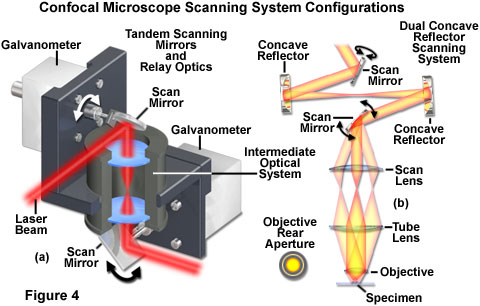
The two-mirror configuration can be utilized without the intervening relay optics by positioning the scanning mirrors as closely as possible, with a shared telecentric plane located at the midpoint between them (Figure 5(a)). This system design has the advantage of optical simplicity and compact size, and has been implemented in instruments developed by Zeiss and other manufacturers. The design achieves only approximate telecentricity, although the closer the mirrors are to each other, the smaller the error. The deviation from ideal performance varies with the characteristics of the microscope intermediate optical configuration, and is usually only significant at low zoom settings, for which large scan angles are required.
An improvement of the close-coupled mirror arrangement, which has been employed by at least one instrument manufacturer, is to position one scan mirror so that its rotational axis is slightly different from the illumination beam axis (Figure 5(b)). This has the effect of shifting the mirror as it rotates, and improves the accuracy with which the mirrors approach the conjugate telecentric plane. The shifting movement of the second mirror is intended to substitute for the function of relay optics, which are not utilized in the close-coupled design. A disadvantage of this design is that successive scan lines in the image frame have slightly different optical path lengths, making the approach unsuitable for use with many microscope optical systems.
Scanning a single mirror on two orthogonal axes is the simplest method of generating a two-dimensional scan raster (see Figure 6). A cardanic scanning system of this type has been implemented by Leica in at least one confocal microscope model. The basic design used is illustrated in Figure 6(a), and functions by incorporating the scan mirror in a small galvanometer head, which itself is mounted on a second larger scan device whose rotational axis passes through the mirror center perpendicular to the galvanometer axis. The fast line scan on the x-axis is accomplished by the small galvanometer, which has low inertia and can respond quickly, while the larger scanner is responsible for the y-scan. The single-mirror arrangement benefits from simplicity and the fact that the mirror is easily located in a telecentric plane of the optical system.
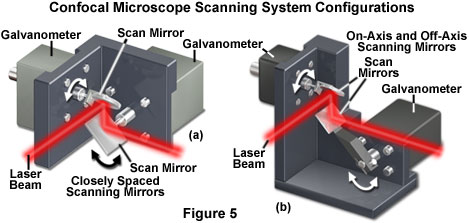
Although the mechanism of accomplishing the x-y raster scan is considered the most crucial aspect of the confocal scanning system, some method of z-axis scanning is necessary in order to acquire series of optical sections for three-dimensional imaging, and to collect x-z or y-z two-dimensional images, as well as to perform any form of free-line z-scanning. Typical microscope configurations change the objective-specimen distance by translating either the objective or the microscope stage. The movement can be performed precisely with a piezoelectric driver or galvanometer device, albeit over a limited distance range. More commonly, however, a microstepper motor is used to drive the fine-focus control of the microscope, and on current instruments the steppers are capable of focus positioning at a minimum step size on the order of 10 micrometers. For biological fluorescence applications, z-positioning to this precision is more than adequate.
Multi-beam scanning techniques offer an alternative to the single-beam scanning configurations, although low illumination efficiency has previously limited their use in high-resolution fluorescence applications. In either the tandem or monoscanning variation, rotating-disk scanners place hundreds of holes, which function as illumination and detection pinholes, in the microscope intermediate image plane. The configuration of a typical Nipkow disk scanning system is presented in Figure 2(b). The holes in the disk are arranged so that a large number of beams uniformly scan the image field as the disk rotates, completely covering the specimen at a much higher rate than that of single-beam scanners. Because disk-scanning microscopes form a real image, a CCD camera may be located directly in the image plane, collecting emitted signal at much greater quantum efficiency than that exhibited by photomultiplier tubes. In spite of this advantage, which allows real-time focusing and imaging of dynamic processes, several shortcomings have limited the practical utility of disk-scanning confocal systems. One of the most serious is the typical reliance on conventional broad-spectrum light sources, and the extreme light loss that occurs at the disk. Advances in design of disk systems and the application of laser sources have helped overcome some of the efficiency problems.
Because each disk has holes of fixed size, the pinhole diameter cannot be matched to the specific objective being used, and consequently the choice of objectives that will perform optimally with a given disk is limited. Furthermore, it is not possible to optimize the diameter of source and detector pinholes independently. Unique optical alignment difficulties exist with the tandem-scanning systems, which require the light rays returning from illumination points on the specimen to exactly align with corresponding holes on the opposite (detector) side of the disk. Precise mirror alignment is essential to prevent any difference in the illumination and detection path lengths, which could cause a variation in magnification and lead to beams in some disk regions missing the detection pinholes. Because of the demanding alignment requirements, tandem-scanning disk systems are typically restricted to using relatively large pinholes, compromising optical section thickness compared to single-beam laser scanning systems. Monoscanning variations of the disk scanner eliminate many of the alignment difficulties, although somewhat elaborate measures are required to reduce reflections from the disk that otherwise limit the detectable signal. Numerous technological improvements aimed at minimizing or eliminating the disadvantages of disk-scanning confocal systems continue to be introduced, and it is likely that configurations of this type will become available that provide sufficient illumination efficiency to enable versatile high-resolution fluorescence imaging within a practical time frame.
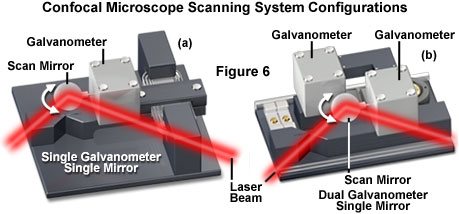
One technique for improving upon the lack of brightness that characterized early Nipkow disk systems is to utilize microlenses to intensify the source light. Older systems transmitted only approximately 1 percent of the illumination incident on the disk, and necessitated the use of either cooled CCD or intensified video cameras to compensate for the low signal level. Newer disk scanning microscope designs incorporate a second disk containing thousands of microlenses, which spins in alignment with the Nipkow disk, and amplifies the light passing in both directions through the Nipkow disk apertures. Some advanced models combine dual spinning disks and microlens technology with laser illumination and cooled CCD detectors to allow fast data acquisition at normal video rates or faster.
Conclusions
Various additional scanner modifications have either been proposed or implemented in the effort to improve some aspect of the practical performance of confocal instruments. Every aspect of confocal fluorescence microscopy is fundamentally related to efficiency, and the inherent limitations of serial data collection. The efficiency with which useful signal can be acquired defines the balance that must be reached between image contrast and photodamage to the specimen, and also controls the required compromise in serial data collection between spatial resolution of the sampling scan, the signal-to-noise ratio, and the rate of image acquisition. The issue of efficiency has particular implications in attempts to perform video-rate single-beam imaging.
There is a strong interest in fast-scanning single beam instruments that can provide imaging at video rates in order to follow dynamic processes in living cells. One approach to such high image frame rates is to utilize rapidly oscillating resonant mirror scanners. Rotating polygon mirror scanners can achieve very high scan speeds, and are used in many optical devices, but do not provide the illumination and detection precision necessary for implementation in high-resolution microscopy. Various configurations combining scanning mirrors with acousto-optic deflectors (AODs) have been explored. In some arrangements, an AOD provides very rapid scanning on one axis, and a mirror scanner controls the slower axis. This approach is acceptable in some applications, but is problematic in confocal fluorescence imaging because it does not allow the longer-wavelength fluorescence emission to be descanned back through the acousto-optic modulator, which is wavelength-specific. The partially descanned signal, still oscillating on one axis, can be passed to a photomultiplier through a slit aperture, or imaged onto a linear-array CCD detector. Although the resulting images are confocal on only one axis, the characteristics are acceptable for some applications.
For high-resolution fluorescence imaging, the most refined and versatile scanning technology currently available is some variation that utilizes galvanometer scanners, and most major microscope manufacturers produce at least one confocal instrument employing this methodology. Because of the importance of photon efficiency, the relative simplicity of single beam scanning techniques give them definite advantages over disk scanners in most fluorescence applications. They are compatible with a wide variety of conventional microscope optical systems and video equipment, they conform well to general microscopy principles, and the flexibility in pinhole adjustment allows optimization to specific optical and specimen variables.
Improvements that have been incorporated over several instrument generations have now culminated in a relatively stable technology with the versatility to accommodate new lasers and fluorescent dyes, which are being continuously developed. With the exception of resonant mirror systems, the galvanometer scanners are not capable of true video-rate imaging, although the implementation of bidirectional high-speed scanning can provide frame rates on the order of 0.25 seconds at reasonable pixel resolution. The benefit of single-beam scanning at video rates is questionable in any case since the photon limitations of acquiring fluorescence data at high magnification makes it difficult to achieve an adequate signal-to-noise ratio, regardless of how the beam scanning is accomplished. If the fluorescence signal is so low that several video frames must be integrated to achieve high-quality images, then there is no advantage in temporal resolution over imaging at slower scan rates, and many experimental approaches are now providing valuable data pertaining to dynamic events, utilizing current state-of-the-art galvanometer scanning systems.
